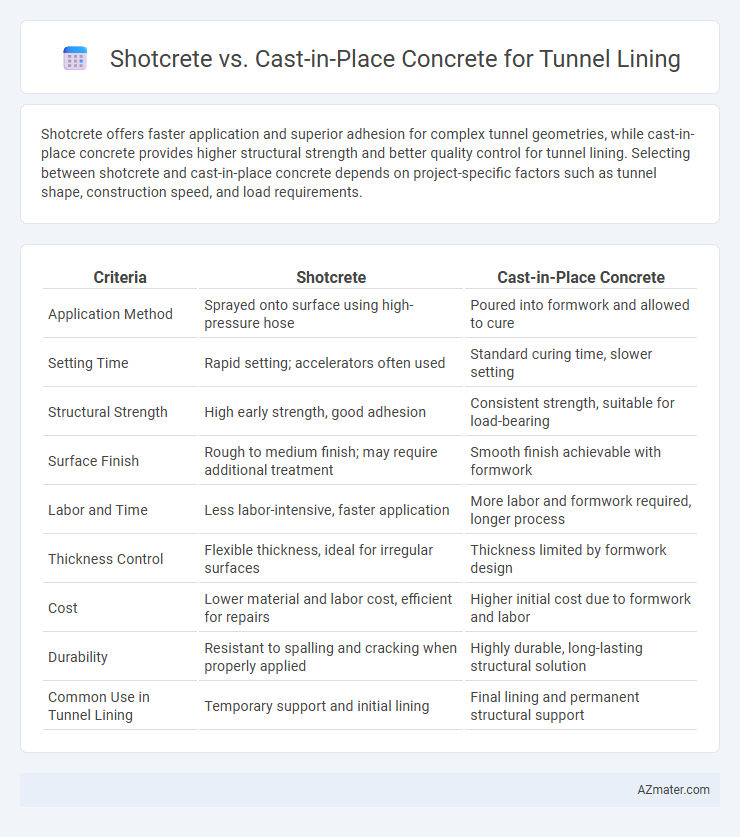Shotcrete offers faster application and superior adhesion for complex tunnel geometries, while cast-in-place concrete provides higher structural strength and better quality control for tunnel lining. Selecting between shotcrete and cast-in-place concrete depends on project-specific factors such as tunnel shape, construction speed, and load requirements.
Table of Comparison
| Criteria | Shotcrete | Cast-in-Place Concrete |
|---|---|---|
| Application Method | Sprayed onto surface using high-pressure hose | Poured into formwork and allowed to cure |
| Setting Time | Rapid setting; accelerators often used | Standard curing time, slower setting |
| Structural Strength | High early strength, good adhesion | Consistent strength, suitable for load-bearing |
| Surface Finish | Rough to medium finish; may require additional treatment | Smooth finish achievable with formwork |
| Labor and Time | Less labor-intensive, faster application | More labor and formwork required, longer process |
| Thickness Control | Flexible thickness, ideal for irregular surfaces | Thickness limited by formwork design |
| Cost | Lower material and labor cost, efficient for repairs | Higher initial cost due to formwork and labor |
| Durability | Resistant to spalling and cracking when properly applied | Highly durable, long-lasting structural solution |
| Common Use in Tunnel Lining | Temporary support and initial lining | Final lining and permanent structural support |
Introduction to Tunnel Lining Methods
Shotcrete and cast-in-place concrete represent two prevalent tunnel lining methods, each offering distinct advantages in construction efficiency and structural integrity. Shotcrete, a pneumatically applied concrete, allows for rapid application and is particularly effective in irregular surfaces and complex tunnel geometries. Cast-in-place concrete provides high strength and durability through formwork casting, making it suitable for tunnels requiring robust, monolithic linings.
Overview of Shotcrete and Cast-in-Place Concrete
Shotcrete involves spraying concrete pneumatically onto surfaces, allowing rapid application and excellent adhesion ideal for irregular tunnel profiles. Cast-in-place concrete is poured into pre-built formwork, creating uniform tunnel linings with high structural integrity and controlled curing. Both methods offer specific advantages, with shotcrete favored for flexibility and speed, while cast-in-place ensures precision and durability in tunnel construction.
Material Properties and Composition Comparison
Shotcrete for tunnel lining features a dry or wet mix of cement, aggregates, and additives applied pneumatically, resulting in high early strength, excellent adhesion, and reduced rebound. Cast-in-place concrete consists of a carefully proportioned mix of cement, coarse and fine aggregates, water, and admixtures, providing uniform density, long-term durability, and superior compressive strength. Material composition differences affect workability, curing time, and mechanical properties, where shotcrete excels in rapid application and flexibility, while cast-in-place concrete offers better structural integrity and consistency.
Installation Process: Shotcrete vs Cast-in-Place
Shotcrete offers rapid application and adaptability for tunnel lining by spraying concrete pneumatically onto surfaces, allowing immediate setting and early support without formwork. Cast-in-place concrete requires extensive formwork installation and longer curing times, leading to slower progress and increased labor costs in confined tunnel environments. The shotcrete method optimizes project timelines and enhances safety by minimizing exposure to open excavations compared to the traditional cast-in-place approach.
Structural Performance and Durability
Shotcrete offers rapid application and superior adhesion on irregular surfaces, enhancing tunnel structural performance by providing immediate support and minimizing deformation risks. Cast-in-place concrete delivers higher compressive strength and better control over material properties, resulting in long-term durability and resistance to environmental stresses such as water ingress and chemical attacks. Choosing between them depends on project-specific factors including load requirements, environmental conditions, and construction speed priorities.
Speed and Efficiency of Construction
Shotcrete offers significantly faster application compared to cast-in-place concrete, allowing for rapid layering directly onto tunnel surfaces without the need for extensive formwork. The pneumatically applied mixture accelerates the construction timeline by reducing curing times and labor requirements. Cast-in-place concrete, while providing robust structural integrity, involves time-consuming form preparation and longer setting periods, making shotcrete more efficient for urgent tunnel lining projects.
Cost Analysis and Economic Factors
Shotcrete offers lower initial labor and formwork costs compared to cast-in-place concrete, making it economically advantageous for complex tunnel geometries and smaller projects. Cast-in-place concrete, while often more expensive upfront due to extensive formwork and longer curing times, provides higher durability and reduced maintenance costs over the tunnel's lifespan. Life cycle cost analysis typically favors shotcrete for rapid construction schedules and cost-sensitive projects, whereas cast-in-place is preferred where structural resilience and long-term performance justify the investment.
Safety Considerations in Application
Shotcrete offers enhanced safety during tunnel lining due to its quick application and ability to conform to irregular surfaces, reducing the risk of structural failures. Cast-in-place concrete requires extensive formwork and longer curing times, increasing exposure to potential hazards such as falling debris and confined space accidents. Proper ventilation and protective measures are critical in both methods to mitigate dust inhalation and ensure worker safety during the curing and application processes.
Environmental Impact and Sustainability
Shotcrete offers a lower environmental footprint due to reduced material waste and shorter curing times compared to cast-in-place concrete, which often requires extensive formwork and longer construction periods. The use of shotcrete enables more efficient resource utilization and less energy consumption, contributing to improved sustainability in tunnel lining projects. In contrast, cast-in-place concrete's higher cement content results in increased CO2 emissions, making shotcrete a greener choice for sustainable tunnel construction.
Selection Criteria for Tunnel Projects
Shotcrete offers rapid application and excellent adaptability to complex tunnel geometries, making it suitable for projects requiring fast stabilization and irregular surface coverage. Cast-in-place concrete provides superior structural integrity and uniformity, favored in tunnels demanding high load-bearing capacity and precise dimensional control. Selection criteria typically weigh factors such as project timeline, load requirements, surface complexity, durability expectations, and cost efficiency to determine the optimal lining method.

Infographic: Shotcrete vs Cast-in-place Concrete for Tunnel Lining
 azmater.com
azmater.com